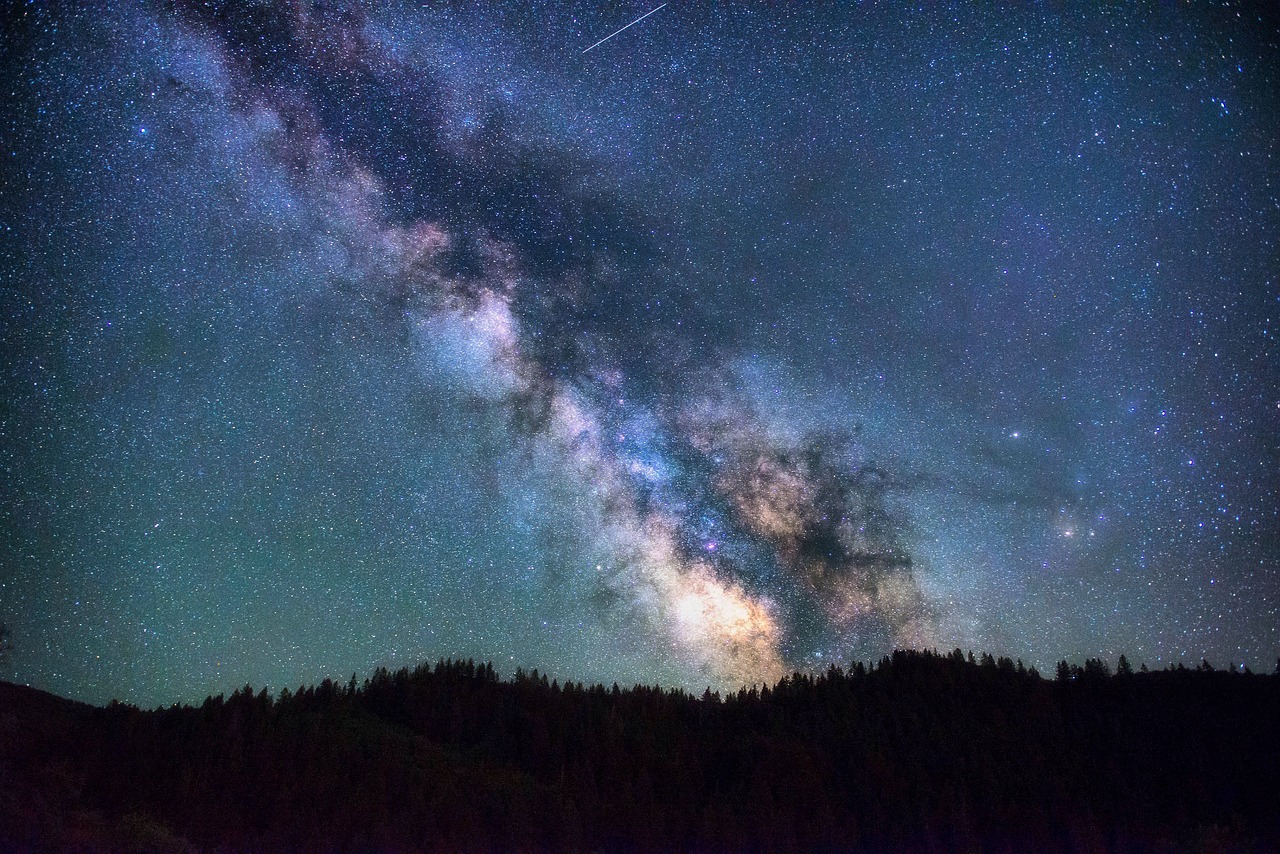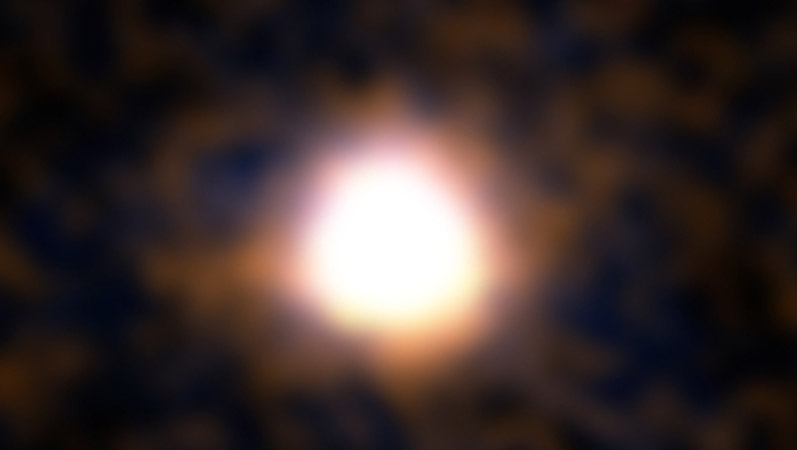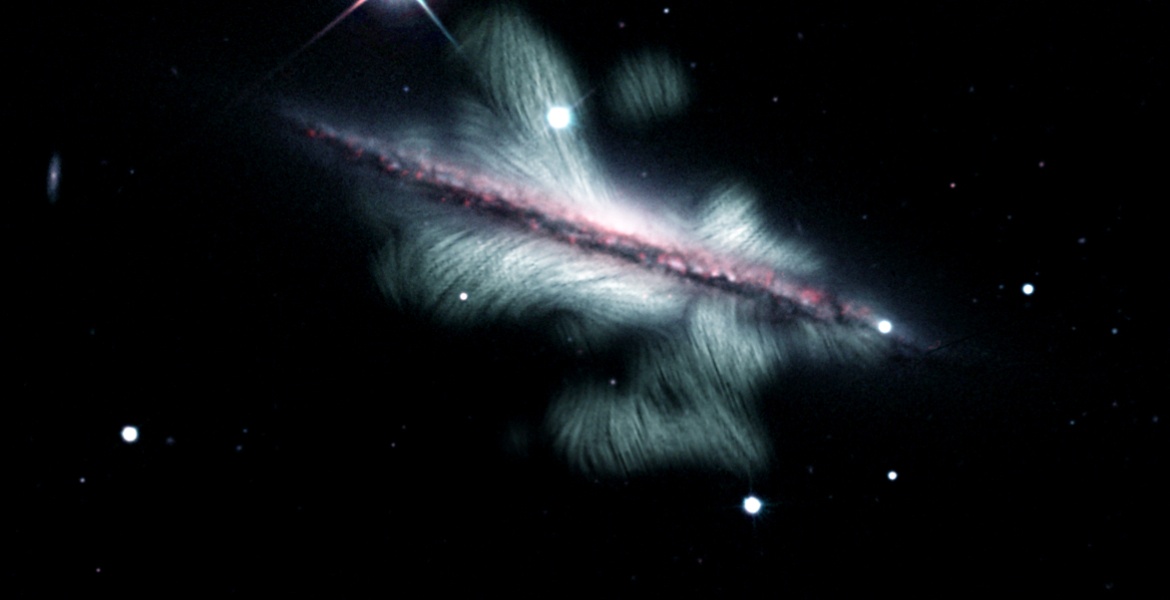At least once, you’ve looked up at the night sky and asked the same longstanding question we’ve all asked at least once, “Are we alone?” With all those points of light out there, we can’t be the only intelligent beings in the universe, right? There must be at least one technological civilization aside from us in the great vastness that we call the cosmos.
Continue reading “What if we’re truly alone?”Galactic Panspermia. How far Could Life Spread Naturally in a Galaxy Like the Milky Way?

Can life spread throughout a galaxy like the Milky Way without technological intervention? That question is largely unanswered. A new study is taking a swing at that question by using a simulated galaxy that’s similar to the Milky Way. Then they investigated that model to see how organic compounds might move between its star systems.
Continue reading “Galactic Panspermia. How far Could Life Spread Naturally in a Galaxy Like the Milky Way?”This galaxy took only 500 million years to form
Galaxies are supposed to build up a very slowly, taking billions of years to acquire their vast bulk. But a newfound galaxy, appearing in the universe when it was only 1.8 billion years old, tells a different tale. It formed stars at a rate hundreds of times greater than the Milky Way, and was able to build itself up to host 200 billion stars in less than 500 million years – perhaps the universe’s greatest speed run.
Continue reading “This galaxy took only 500 million years to form”Gaia has Already Given Us 5 New Insights Into the Milky Way
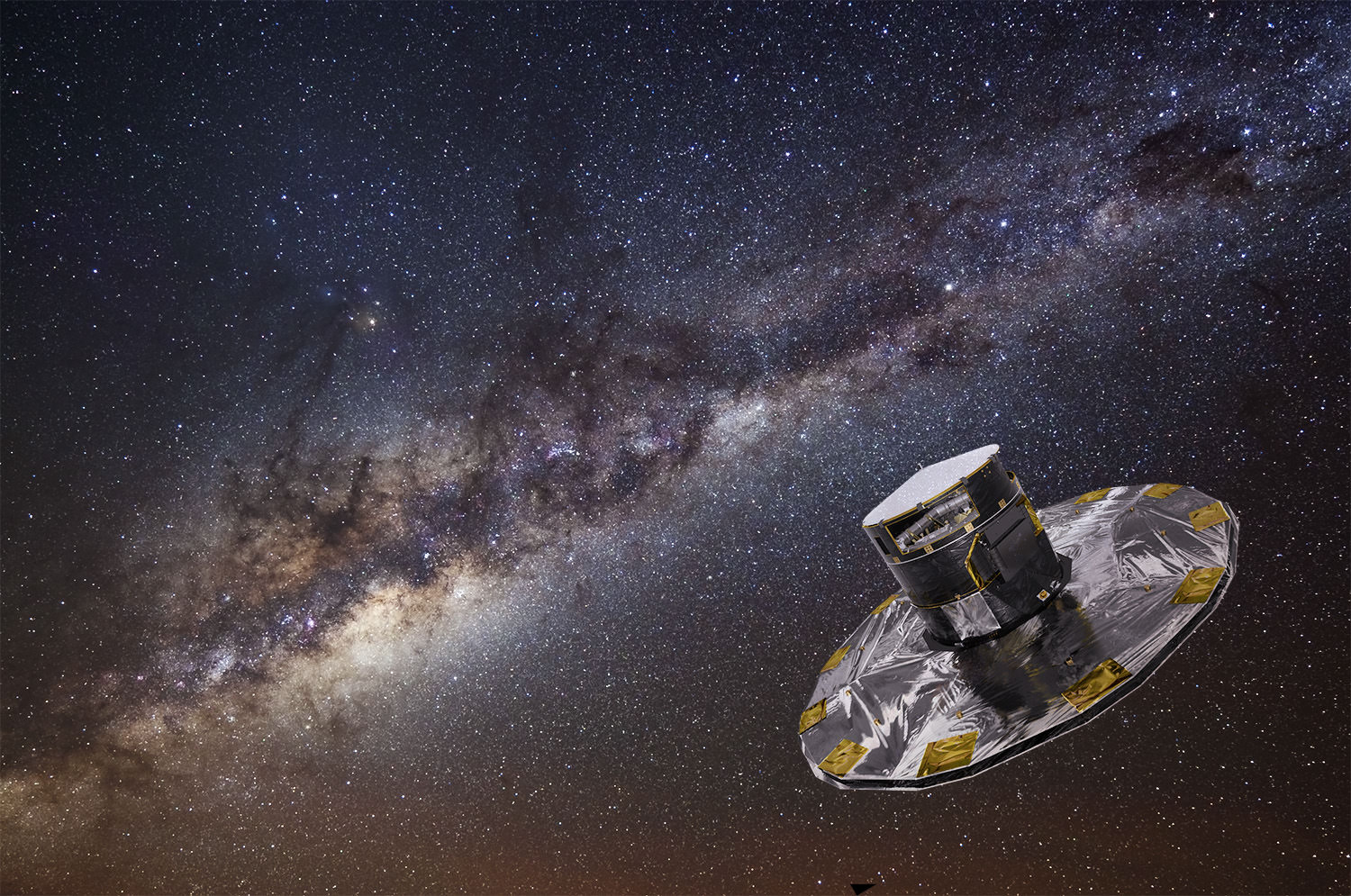
The European Space Agency launched the Gaia mission in 2013. The mission’s overall goal was to discover the history of the Milky Way by mapping out the positions and velocities of one billion stars. The result is kind of like a movie that shows the past and the future of our galaxy.
The mission has released two separate, massive data sets for researchers to work through, with a third data release expected soon. All that data has spawned a stream of studies into our home galaxy.
Recently, the ESA drew attention to five new insights into the Milky Way galaxy. Allof these discoveries directly stemmed from the Gaia spacecraft.
Continue reading “Gaia has Already Given Us 5 New Insights Into the Milky Way”This Is Fascinating. An Image of a Galaxy’s Magnetic Field
There’s always more than one way to look at the world. There’s also more than one way to look at a galaxy. And sometimes combining those ways of looking can result in something truly special.
That is what happened recently when a team of astronomers from seven different universities in four different countries used three different telescopes to produce an absolutely spectacular image of a galaxy and its surrounding magnetic field.
Continue reading “This Is Fascinating. An Image of a Galaxy’s Magnetic Field”What Is the Name Of Our Galaxy?

Since prehistoric times, human beings have looked up at at the night sky and pondered the mystery of the band of light that stretches across the heavens. And while theories have been advanced since the days of Ancient Greece as to what it could be, it was only with the birth of modern astronomy that scholars have come come to know precisely what it is – i.e. countless stars at considerable distances from Earth.
The term “Milky Way”, a term which emerged in Classical Antiquity to describe the band of light in the night sky, has since gone on to become the name for our galaxy. Like many others in the known Universe, the Milky Way is a barred, spiral galaxy that is part of the Local Group – a collection of 54 galaxies. Measuring 100,000 – 180,000 light-years in diameter, the Milky Way consists of between 100 and 400 billion stars.
Structure:
The Milky Way consists of a Galactic Center that is shaped like a bar and a Galactic Disk made up of spiral arms, all of which is surrounded by the Halo – which is made up of old stars and globular clusters. The Center, also known as “the bulge”, is a dense concentration of mostly old stars that measures about 10,000 light years in radius. This region is also the rotational center of the Milky Way.
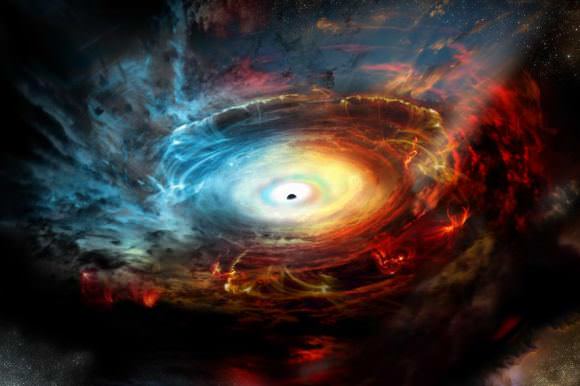
The Galactic Center is also home to an intense radio source named Sagittarius A*, which is believed to have a supermassive black hole (SMBH) at its center. The presence of this black hole has been discerned due to the apparent gravitational influence it has on surrounding stars. Astronomers estimate that it has a mass of between 4.1. and 4.5 million Solar masses.
Outside the barred bulge at the Galactic Center is the Galactic Disk of the Milky Way. This consists of stars, gas and dust which is organized into four spiral arms. These arms typically contain a higher density of interstellar gas and dust than the Galactic average, as well as a greater concentration of star formation. While there is no consensus on the exact structure or extent of these spiral arms, they are commonly grouped into two or four different arms.
In the case of four arms, this is based on the traced paths of gas and younger stars in our galaxy, which corresponds to the Perseus Arm, the Norma and Outer Arm, the Scutum-Centaurum Arm, and the Carina-Sagittarius Arm. There are also at least two smaller arms, which include the Cygnus Arm and the Orion Arm. Meanwhile, surveys based on the presence of older stars show only two major spirals arms – the Perseus arm and the Scutum–Centaurus arm.
Beyond the Galactic Disk is the Halo, which is made up of old stars and globular clusters – 90% of which lie within 100,000 light-years (30,000 parsecs) from the Galactic Center. Recent evidence provided by X-ray observatories indicates that in addition to this stellar halo, the Milky way also has a halo of hot gas that extends for hundreds of thousands of light years.
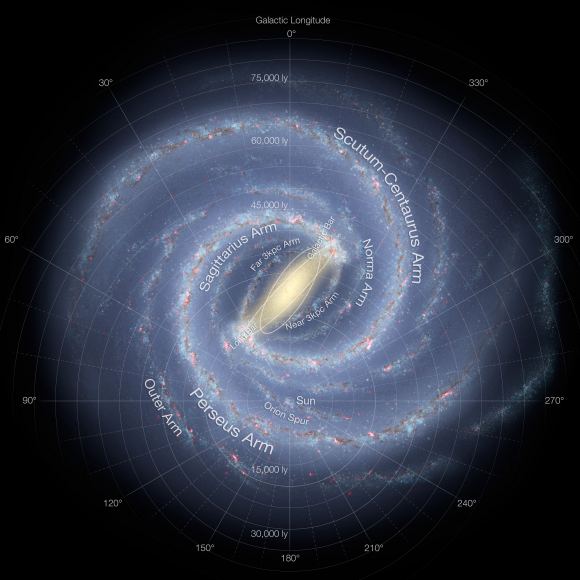
Size and Mass:
The Galactic Disk of the Milky Way Galaxy is approximately 100,000 light years in diameter and about 1,000 light years thick. It is estimated to contain between 100 and 400 billion stars, though the exact figure depends on the number of very low-mass M-type (aka. red dwarf) stars. This is difficult to determine because these stars also have low-luminosity compared to other class.
The distance from the Sun to the Galactic Center is estimated to be between 25,000 to 28,000 light years (7,600 to 8,700 parsecs). The Galactic Center’s bar (aka. its “bulge”) is thought to be about 27,000 light-years in length and is composed primarily of red stars, all of which are thought to be ancient. The bar is surrounded by the ‘5-kpc ring’, a region that contains much of the galaxy’s molecular hydrogen and where star-formation is most intense.
The Galactic Disk has a diameter of between 70,000 and 100,000 light-years. It does not have a sharp edge, a radius beyond which there are no stars. However, the number of stars drops slowly with distance from the center. Beyond a radius of roughly 40,000 light years, the number of stars drops much faster the farther you get from the center.
Location of the Solar System:
The Solar System is located near the inner rim of the Orion Arm, a minor spiral arm located between the Carina–Sagittarius Arm and the Perseus Arm. This arm measures some 3,500 light-years (1,100 parsecs) across, approximately 10,000 light-years (3,100 parsecs) in length, and is at a distance of about 25,400 to 27,400 light years (7.78 to 8.4 thousand parsecs) from the Galactic Center.
History of Observation:
Our galaxy was named because of the way the haze it casts in the night sky resembled spilled milk. This name is also quite ancient. It is translation from the Latin “Via Lactea“, which in turn was translated from the Greek for Galaxias, referring to the pale band of light formed by stars in the galactic plane as seen from Earth.
Persian astronomer Nasir al-Din al-Tusi (1201–1274) even spelled it out in his book Tadhkira: “The Milky Way, i.e. the Galaxy, is made up of a very large number of small, tightly clustered stars, which, on account of their concentration and smallness, seem to be cloudy patches. Because of this, it was likened to milk in color.”
Astronomers had long suspected the Milky Way was made up of stars, but it wasn’t proven until 1610, when Galileo Galilei turned his rudimentary telescope towards the heavens and resolved individual stars in the band across the sky. With the help of telescopes, astronomers realized that there were many, many more stars in the sky, and that all of the ones that we can see are a part of the Milky Way.
In 1755, Immanuel Kant proposed that the Milky Way was a large collection of stars held together by mutual gravity. Just like the Solar System, this collection would be rotating and flattened out as a disk, with the Solar System embedded within it. Astronomer William Herschel (discoverer of Uranus) tried to map its shape in 1785, but he didn’t realize that large portions of the galaxy are obscured by gas and dust, which hide its true shape.
It wasn’t until the 1920s, when Edwin Hubble provided conclusive evidence that the spiral nebulae in the sky were actually whole other galaxies, that the true shape of our galaxy was known. Thenceforth, astronomers came to understand that the Milky Way is a barred, spiral galaxy, and also came to appreciate how big the Universe truly is.
The Milky Way is appropriately named, being the vast and cloudy mass of stars, dust and gas it is. Like all galaxies, ours is believed to have formed from many smaller galaxies colliding and combining in the past. And in 3 to 4 billion years, it will collide with the Andromeda Galaxy to form an even larger mass of stars, gas and dust. Assuming humanity still exists by then (and survives the process) it should make for some interesting viewing!
We have written many interesting articles about the Milky Way here at Universe Today. Here’s 10 Interesting Facts About the Milky Way, How Big is the Milky Way?, Why is our Galaxy Called the Milky Way?, What is the Closest Galaxy to the Milky Way?, Where is the Earth in the Milky Way?, The Milky Way has Only Two Spiral Arms, and It’s Inevitable: Milky Way, Andromeda Galaxy Heading for Collision.
If you’d like more info on galaxies, check out Hubblesite’s News Releases on Galaxies, and here’s NASA’s Science Page on Galaxies.
We’ve also recorded an episode of Astronomy Cast about the Milky Way. Listen here, Episode 99: The Milky Way.
Sources:
Weekly Space Hangout – May 26, 2017: Stephen Petranek and How We’ll Live On Mars
Host: Fraser Cain (@fcain)
Special Guest:
NAT GEO’s Stephen Petranek is the author of How We’ll Live on Mars (TED Books.) Stephen became a reluctant doomsayer when his earliest TED Talk (10 Ways the World Could End) racked up 1.5 million views. But Petranek is, in fact, an optimist who believes that humanity will escape its predicaments — literally. Within a century, he predicts that humans will have established a city of 80,000 on Mars: and that not only is that plausible, but it’s also inevitable.
Having worked in publishing for four decades — most of it straddling the line with science and technology, Petranek is the former editor-in-chief of Discover magazine, editor of the Washington Post’s magazine, and a renown TED Talk speaker has also given him some unique perspective and insight on the changes that lie ahead and new tools that reflect a potential disruptive shift in how we observe the world around us. Petranek is the editor-in-chief of the Breakthrough Technology Alert, a technology newsletter that ties scientific breakthroughs to investment opportunities.
Guests:
Dr. Kimberly Cartier ( KimberlyCartier.org / @AstroKimCartier )
Nicole Gugliucci (cosmoquest.org / @noisyastronomer)
Paul M. Sutter (pmsutter.com / @PaulMattSutter)
Their stories this week:
Boyajian’s Star is at it again
Q&A about the new dipping event
Familiar Galaxy Shows New Object in the Radio
Gravitational Waves Alter Spacetime?
Defining a new stage of planet formation
We use a tool called Trello to submit and vote on stories we would like to see covered each week, and then Fraser will be selecting the stories from there. Here is the link to the Trello WSH page (http://bit.ly/WSHVote), which you can see without logging in. If you’d like to vote, just create a login and help us decide what to cover!
Announcements:
The WSH recently welcomed back Mathew Anderson, author of “Our Cosmic Story,” to the show to discuss his recent update. He was kind enough to offer our viewers free electronic copies of his complete book as well as his standalone update. Complete information about how to get your copies will be available on the WSH webpage – just visit http://www.wsh-crew.net/cosmicstory for all the details.
If you’d like to join Fraser and Paul Matt Sutter on their Tour to Iceland in February 2018, you can find the information at astrotouring.com.
If you would like to join the Weekly Space Hangout Crew, visit their site here and sign up. They’re a great team who can help you join our online discussions!
We record the Weekly Space Hangout every Friday at 12:00 pm Pacific / 3:00 pm Eastern. You can watch us live on Universe Today, or the Universe Today YouTube page
Are There Dark Matter Galaxies? ft. Sarah Pearson from Space with Sarah
One of the things I love about astronomy is how it’s rapidly changing and evolving over time. Every day there are new discoveries, and advancements in theories that take us incrementally forward in our understanding of the Universe.
One of the best examples of this is dark matter; mysterious and invisible but a significant part of the Universe and accounting for the vast majority of mass out there.
It was first theorized almost 100 years ago when astronomers surveyed the total mass of distant galaxy clusters and found that the visible mass we can see must be just a fraction of the total material in the clusters. When you add up the stars and gas, galaxies move and rotate in ways that indicate there’s a huge halo of invisible matter surrounding it.
Some of the best evidence came from Vera Rubin and Kent Ford in the 60s and 70s, when they measured the rotational velocity of edge-on spiral galaxies. They estimated that there must be about 6 times as much dark matter as regular matter.
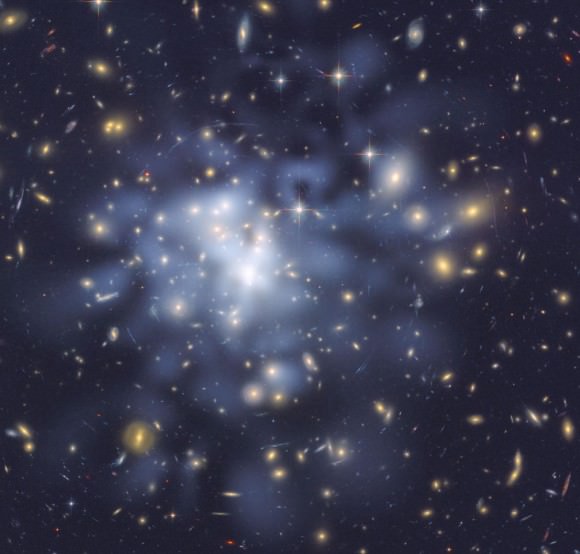
Dark matter became a serious mystery in astronomy, and many observers and theorists have spent the last half century trying to work out what it is.
And dark matter hasn’t given up its secrets easily. Originally, astronomers thought it might not actually be invisible mass, but a misunderstanding of how gravity works at the largest scales.
But over the last few decades, techniques have been developed, using the gravity of dark matter itself to measure how it bends light from more distant objects. Astronomers don’t know what dark matter is, but they’re able to use it as a telescope. Now that’s impressive.
They’ve found amazing features in the dark matter web out there, vast walls and filaments defining the largest scale structures in the Universe. Clusters where dark matter and its gas have been separated from each other.
Remember, we are at the cutting edge of this mystery, and you’re watching it unfold in real time. 25 years from now, I’m sure we’ll look back at our quaint attempts to understand dark matter.
One of the most interesting questions I have right now is: could there be dark matter galaxies? Completely invisible to our eyes, but able to interact through gravity?
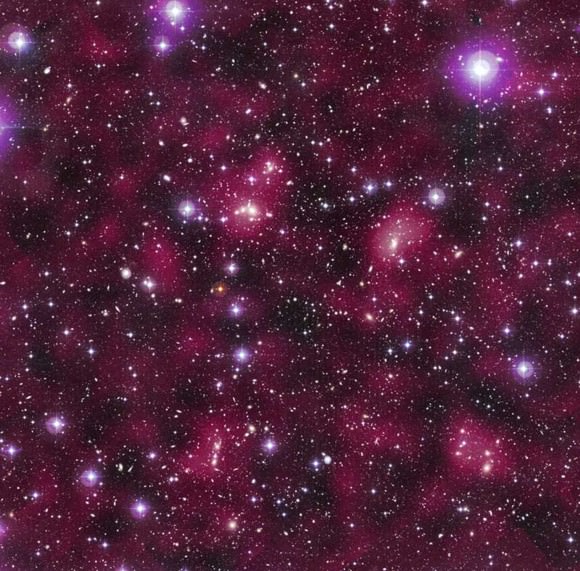
Of course, in times like this, I like to bring in a ringer. Someone who has dedicated their life to the study of these questions.
And today, I’ve got with my Sarah Pearson, a graduate student in astronomy at Columbia University and the host of “Space with Sarah”. Sarah studies the formation and interactions of dwarf galaxies surrounding the Milky Way to understand how galaxies built up at the earliest times in the Universe and form the large galaxies we see at present day.
Fraser: Sarah, welcome to the Guide to Space.
Sarah: Hi Fraser, thanks.
Fraser: Can you talk a little bit about how astronomers map out the distribution of dark matter in the Universe?
Sarah: Yes, definitely. So that is a hard question, as you just explained, we don’t see the dark matter. But one assumption about the Universe we live in is that the light matter or baryonic matter. For example, what you, me and stars consist of, and also galaxies, kind of trace out where the dark matter is located.
So one assumption is that the light matter follows the dark matter. In that way we can actually map out to huge distances, kind of how galaxies and clusters of galaxies are located in our Universe. And we imagine that the dark matter structure is somewhat similar.
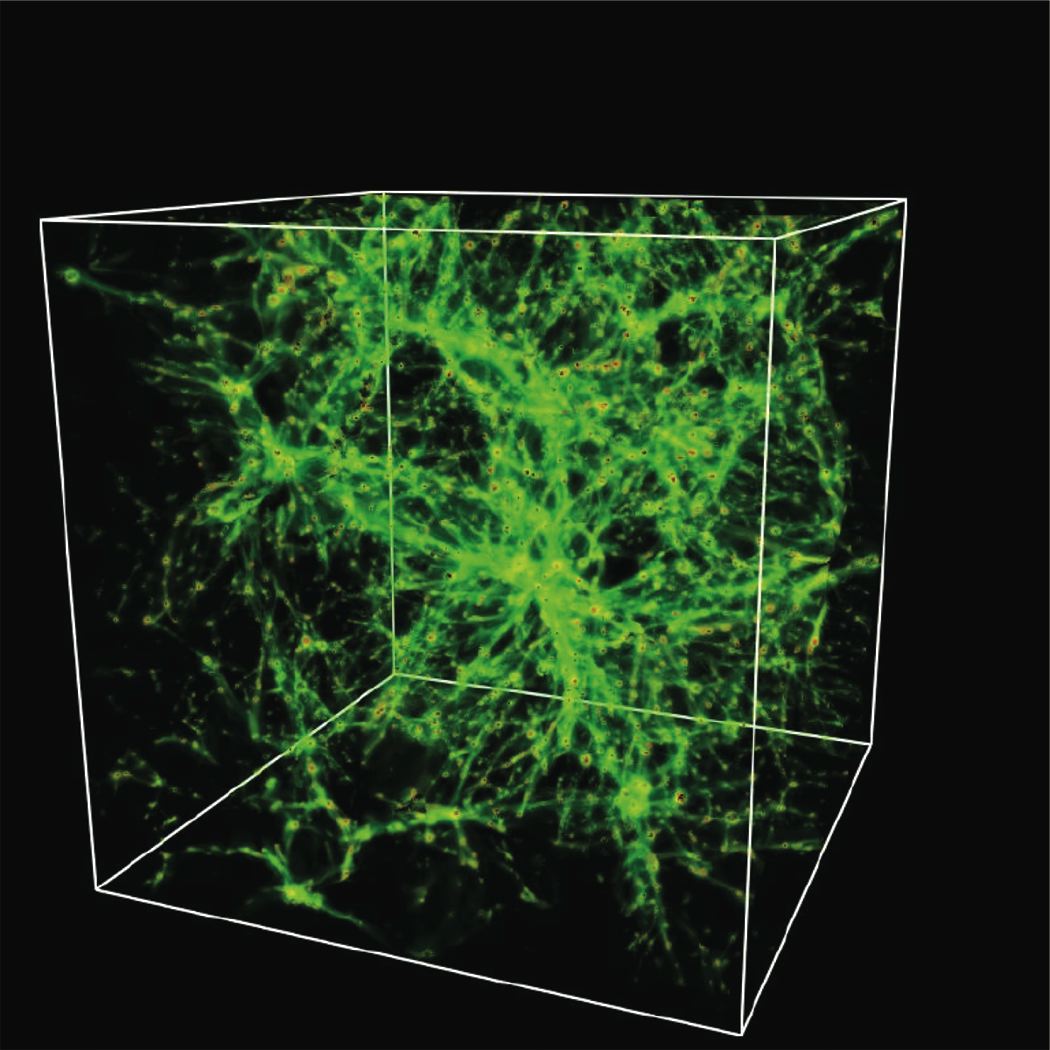
And also recently, very large scale structure simulations of our own Universe have addressed this by kind of starting out with an almost uniform distribution of dark matter in the very early Universe. And what they see is when they let the Universe evolve in time, for example, when the Universe is expanding, you kind of have these dark matter clumps forming into galaxies in all these filaments that you discussed.
You can kind of trace out the location of dark matter by understanding the expansion of space versus gravity that creates the galaxies that we see.
Fraser: And I know in the observations that you see these different distributions of matter and dark matter, it’s not the perfect 1:6 radio that I just mentioned before. You actually see clumping of dark matter that’s sometimes separated from regular matter. So can you actually have whole galaxies that are entirely made of dark matter?
Sarah: Yes, that’s one of the topics I’m super excited about. I work on some of these dark matter only galaxies, and the way you can think about it is that the dark matter is almost uniformly distributed in the early Universe. But some of it is slightly denser than other parts, which collapses down into galaxies. And a lot of those galaxies will actually be a lot smaller than the Milky Way. And because they’re so small, they have a hard time actually holding onto the matter within them.
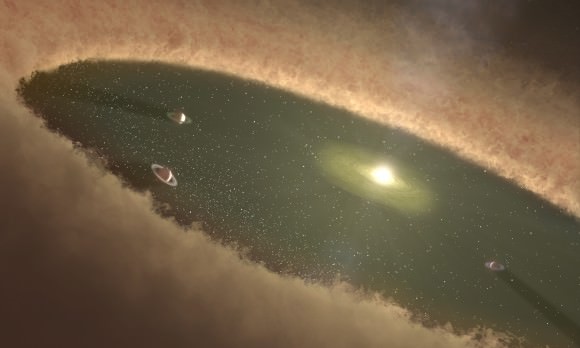
We think that when star formation turned on in these galaxies, you might actually blow out a lot of the gas that might create more stars, but you won’t blow out the dark matter. That means you could end up with these small tiny galaxies that only have dark matter. They might have some gas, but they’re very hard for us astronomers to find.
Fraser: Well, if they are dark matter, and the dark matter is invisible, how do we find them?
Sarah: Oh, great question. So for example, around our own galaxy Milky Way, it’s hypothesized in our current paradigm of cosmology and the way we think about the Universe, there should actually be thousands of dark matter clumps, these dark matter galaxies, kind of orbiting our own galaxy.
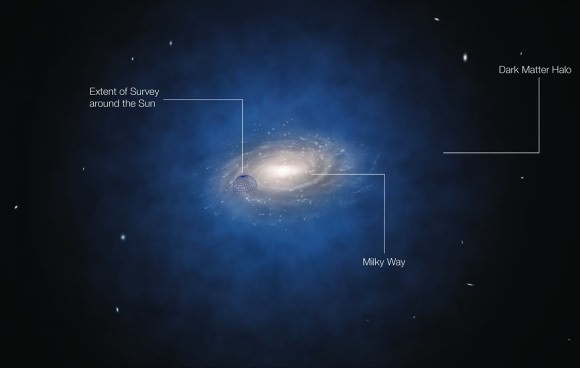
Some of these might be destroyed when they pass through the huge Milky Way disk, that’s one way of destroying them. The smaller ones might be destroyed just by the tides as they orbit around the galaxy. However, we imagine that some of them might survive. Actually they can plough through what we call stellar streams, which are formed when a real galaxy falls into our own Milky Way and tidally stretched out. You should be able to see these density signatures in the stellar stream, and that might indicate what type of dark matter halo that ploughed through them.
Fraser: You hinted at a way that they could form. You’ve got these stars as they’re early forming and blasting themselves apart and the clump of dark matter can’t hold onto them, so that part is gone. Is that the main way these might form, are there other ways you can get these dark galaxies?
Sarah: A different hypothesis is if you have an AGN, an active galactic nuclei within a galaxy from a black hole, you could actually that way blow out a lot of the gas from a galaxy as well. But it’s still not really clear to us astronomers what type of galaxies and if small galaxies would have these active galactic nuclei.
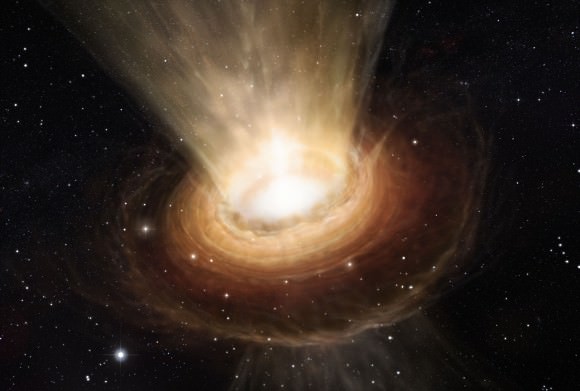
So the best theory right now is that some of them might have attracted a lot of gas initially because they didn’t have a lot of gravity to pull in the gas. But also, because this gas is completely lost. Also from stars exploding, actually, not just from stars turning on initially.
Fraser: And I know that astronomers and physicists are trying to search for dark matter in the Large Hadron Collider, and try to see if they can understand the underlying particle. Does the search that you’re working on give us any sense of that underlying nature of dark matter?
Sarah: Yeah, also a great question, because for example if dark matter is cold. The cold dark matter paradigm is very popular right now. Which states that dark matter might be a very massive weakly interacting particle. When we’re saying warm or cold dark matter, we’re also referring to how fast it’s moving. And depending on what kind of particle dark matter is, that kind of sets the structure for of the early Universe.
So we can start to count, if we have cold dark matter, we would expect to see a certain amount of these cold dark galaxies, where that amount would be different, if we had warm dark matter.
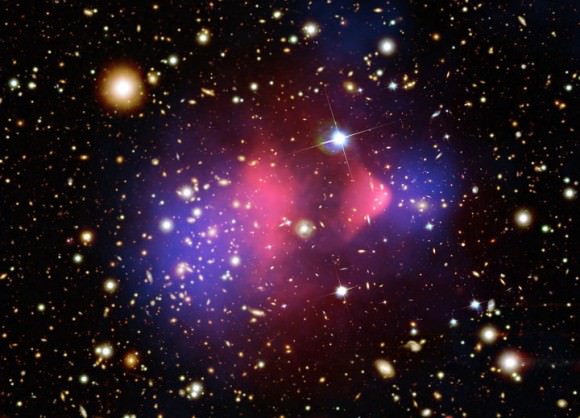
Fraser: That’s really cool, so the observations that you do give the physicists a better idea of what they should be looking for in their particle accelerators, and the two sides can work together. That’s really great.
Okay Sarah, place your bets. What do you think is the most likely candidate for dark matter?
Sarah: I still think this is a hard question, and I’m not sure if the particle physicists yet think we’re helping them. We’re still approaching things from different sides, but we’ll see.
I still think it’s going to be one of those weakly interactive massive particles that we just haven’t detected yet.
Fraser: Thank you so much for joining me on the Guide to Space Sarah, I really appreciate you explaining these dark matter galaxies to us.
Well there you have it. Dark matter is strange, strange stuff. We still don’t know what it is, but we can see how it moves, interacts with matter through its gravity. And we can see how it can form entire galaxies of just dark matter.
A big thanks to Sarah Pearson. If you haven’t already, go and check out her YouTube channel: Space with Sarah. She’s covering big topics, like wondering when the Sun will shut off, how big the Universe is, and how galaxies can collide in an expanding Universe.
Terzan 5 May Unlock Secret to Milky Way’s Past
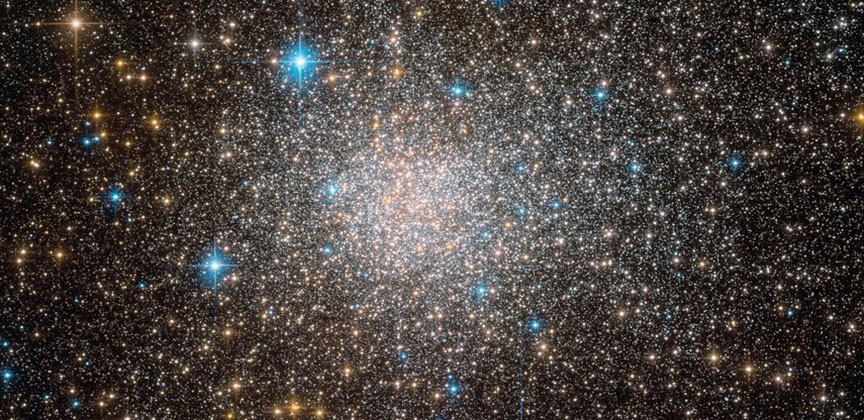

Not many people have heard of the globular star cluster Terzan 5. It’s a big ball of stars resembling spilled sugar like so many other globular clusters. A very few globulars are bright enough to see with the naked eye; Terzan 5 is faint because it lies far away in the direction of the center of Milky Way galaxy inside its central bulge. Here, the stars that formed at the galaxy’s birth are packed together in great numbers. They are the “old ones” of the Milky Way.
Today, a team of astronomers revealed that Terzan 5 is unlike any globular cluster known. Most Milky Way globulars contain stars of just one age, about 11-12 billion years. They formed around the same time as the Milky Way itself, used up all their available gas early to build stars and then spent the remaining billions of years aging. Most orbit the galaxy’s center in a vast halo like moths whirring around a bright light. Oddball Terzan 5 has two populations aged 12 billion and 4.5 billion years old and it’s located inside the galactic bulge.

The team used the cameras on the Hubble Space Telescope as well as a host of ground-based telescopes to find compelling evidence for the two distinct kinds of stars. Not only do they show a large gap in age, but the differ in the elements they contain. Terzan 5’s dual populations point to a star formation process that wasn’t continuous but dominated by two distinct bursts of star formation.
“This requires the Terzan 5 ancestor to have large amounts of gas for a second generation of stars and to be quite massive. At least 100 million times the mass of the Sun,” explains Davide Massari, co-author of the study.
Its unusual properties make Terzan 5 the ideal candidate for the title of “living fossil” from the early days of the Milky Way. Current theories on galaxy formation assume that vast clumps of gas and stars interacted to form the primordial bulge of the Milky Way, merging and dissolving in the process.
While the properties of Terzan 5 are uncommon for a globular cluster, they’re very similar to the stars found in the galactic bulge. Remnants of those gaseous clumps appear to have stuck around intact since the days of our galaxy’s birth, one of them evolving into the present day Terzan 5. That makes it a relic from the Milky Way’s infant days and one of the earliest galactic building blocks. Later, the cluster, which held onto some of its remaining gas, experienced a second burst of star formation.
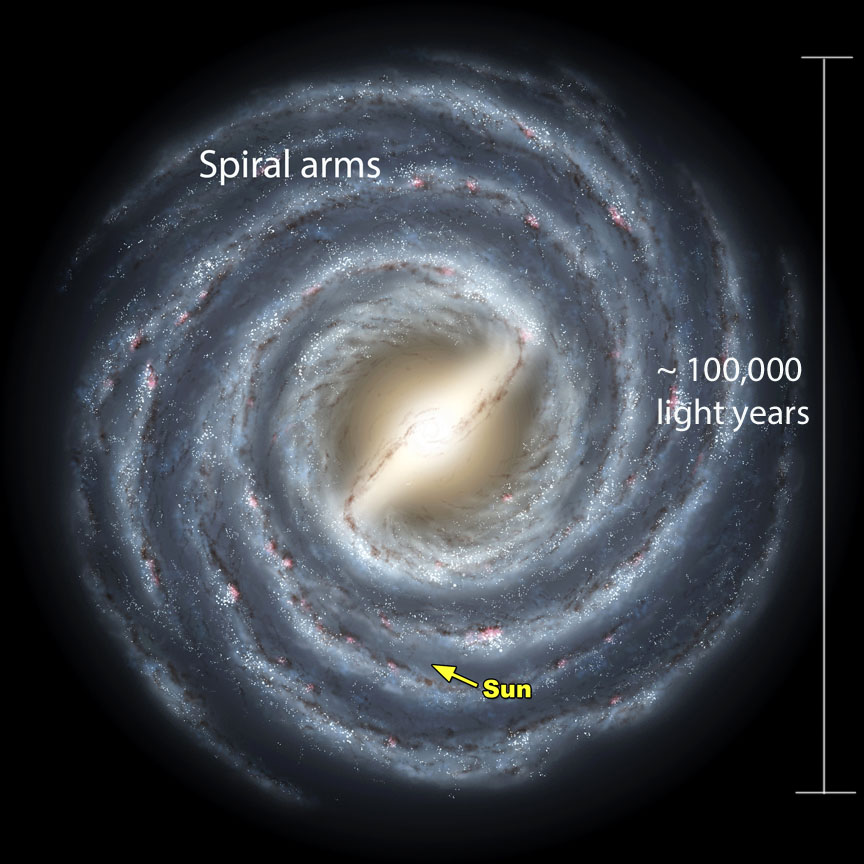
“Some characteristics of Terzan 5 resemble those detected in the giant clumps we see in star-forming galaxies at high-redshift (galaxies just beginning to form in the remote universe in the far distant past), suggesting that similar assembling processes occurred in the local and in the distant universe at the epoch of galaxy formation,” said Dr. Francesco Ferraro from the University of Bologna, Italy, who headed up the team.
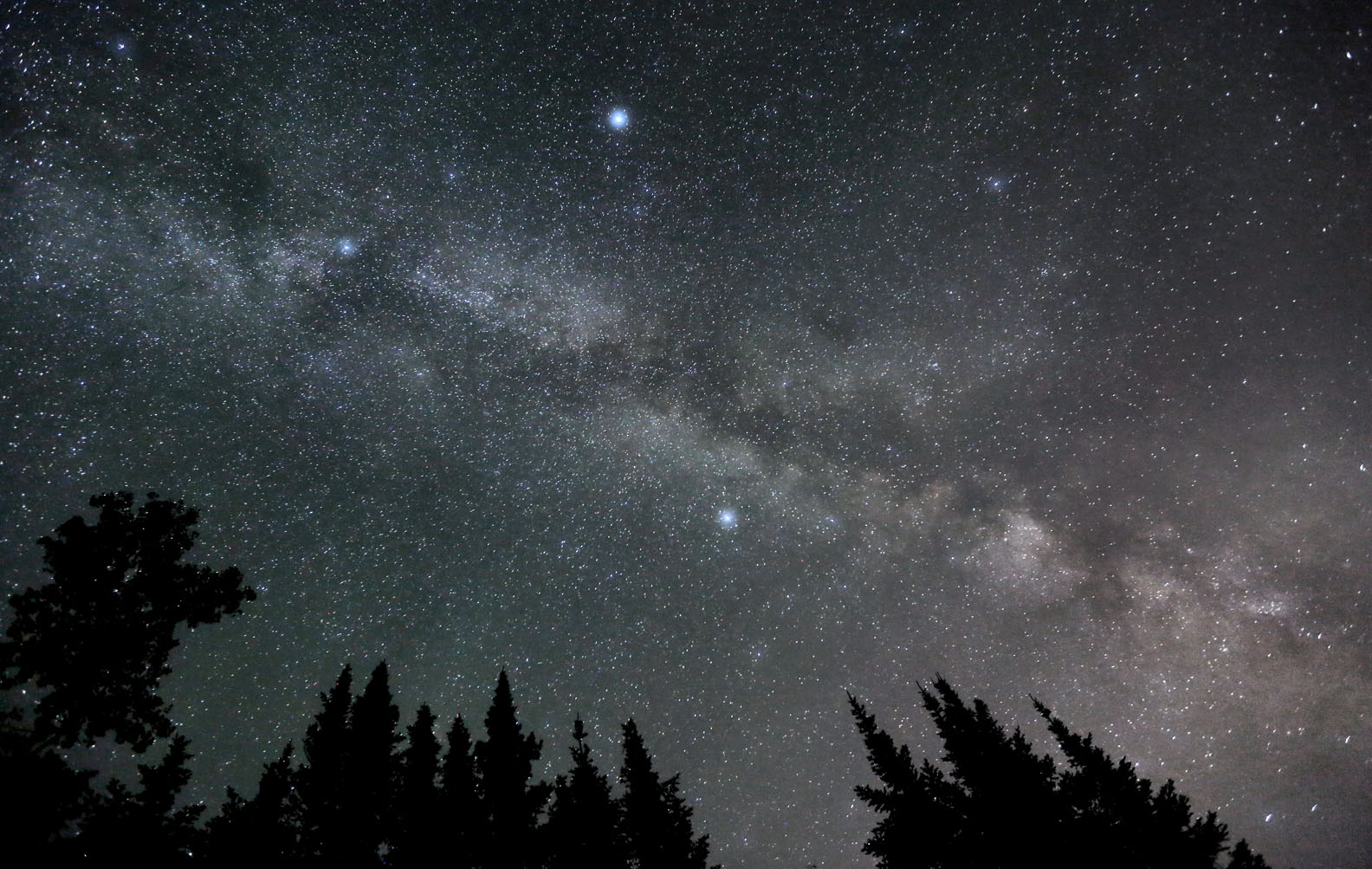
Terzan 5’s chandelier-like presence is helping astronomers understand how our galaxy was assembled. Reconstructing the past is one of the key occupations of astronomy. The present is continually departing with every passing moment. Soon enough, every piece of information slips into the past tense. In the near-past, which records humanity’s comings and goings, details are often forgotten or lost. The deep past is even worse. With no one around and only scattered clues, astronomers continually look for fragmental remains that when woven into the fabric of a theory, reveal patterns and processes before we came to be.
18 Billion Solar Mass Black Hole Rotates At 1/3 Speed Of Light
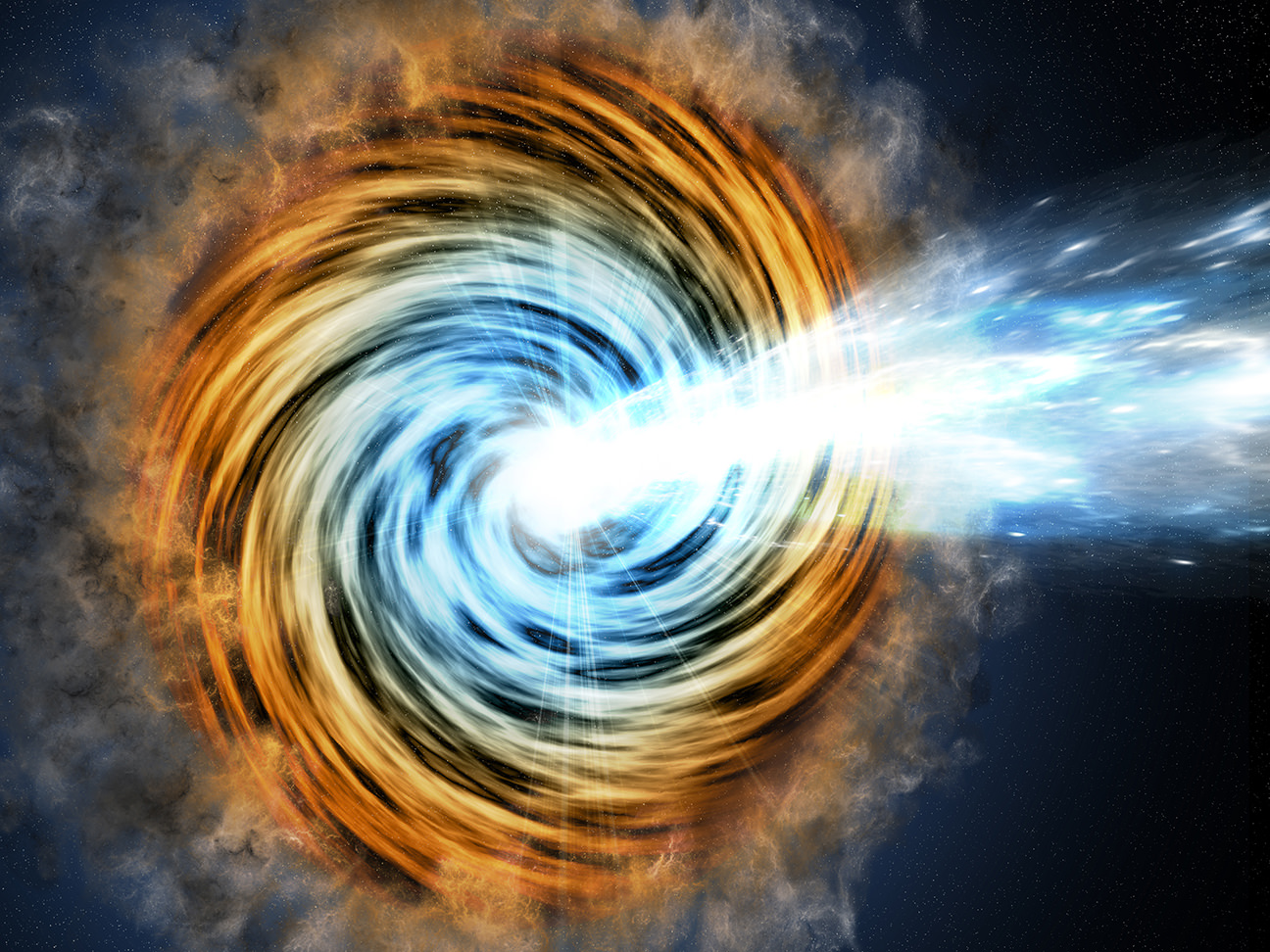
Way up in the constellation Cancer there’s a 14th magnitude speck of light you can claim in a 10-inch or larger telescope. If you saw it, you might sniff at something so insignificant, yet it represents the final farewell of chewed up stars as their remains whirl down the throat of an 18 billion solar mass black hole, one of the most massive known in the universe.

Credits: M. Weiss/CfA
Astronomers know the object as OJ 287, a quasar that lies 3.5 billion light years from Earth. Quasars or quasi-stellar objects light up the centers of many remote galaxies. If we could pull up for a closer look, we’d see a brilliant, flattened accretion disk composed of heated star-stuff spinning about the central black hole at extreme speeds.
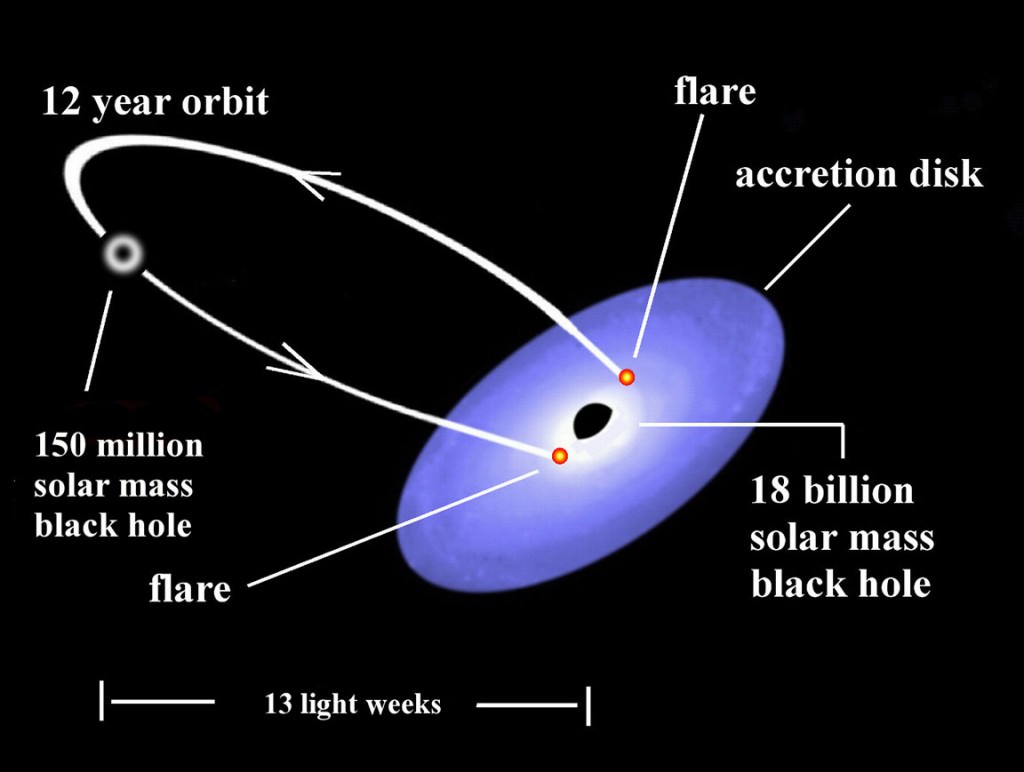
As matter gets sucked down the hole, jets of hot plasma and energetic light shoot out perpendicular to the disk. And if we’re so privileged that one of those jet happens to point directly at us, we call the quasar a “blazar”. Variability of the light streaming from the heart of a blazar is so constant, the object practically flickers.

A recent observational campaign involving more than two dozen optical telescopes and NASA’s space based SWIFT X-ray telescope allowed a team of astronomers to measure very accurately the rotational rate the black hole powering OJ 287 at one third the maximum spin rate — about 56,000 miles per second (90,000 kps) — allowed in General Relativity A careful analysis of these observations show that OJ 287 has produced close-to-periodic optical outbursts at intervals of approximately 12 years dating back to around 1891. A close inspection of newer data sets reveals the presence of double-peaks in these outbursts.

To explain the blazar’s behavior, Prof. Mauri Valtonen of the University of Turku (Finland) and colleagues developed a model that beautifully explains the data if the quasar OJ 287 harbors not one buy two unequal mass black holes — an 18 billion mass one orbited by a smaller black hole.
OJ 287 is visible due to the streaming of matter present in the accretion disk onto the largest black hole. The smaller black hole passes through the larger’s the accretion disk during its orbit, causing the disk material to briefly heat up to very high temperatures. This heated material flows out from both sides of the accretion disk and radiates strongly for weeks, causing the double peak in brightness.
The orbit of the smaller black hole also precesses similar to how Mercury’s orbit precesses. This changes when and where the smaller black hole passes through the accretion disk. After carefully observing eight outbursts of the black hole, the team was able to determine not only the black holes’ masses but also the precession rate of the orbit. Based on Valtonen’s model, the team predicted a flare in late November 2015, and it happened right on schedule.
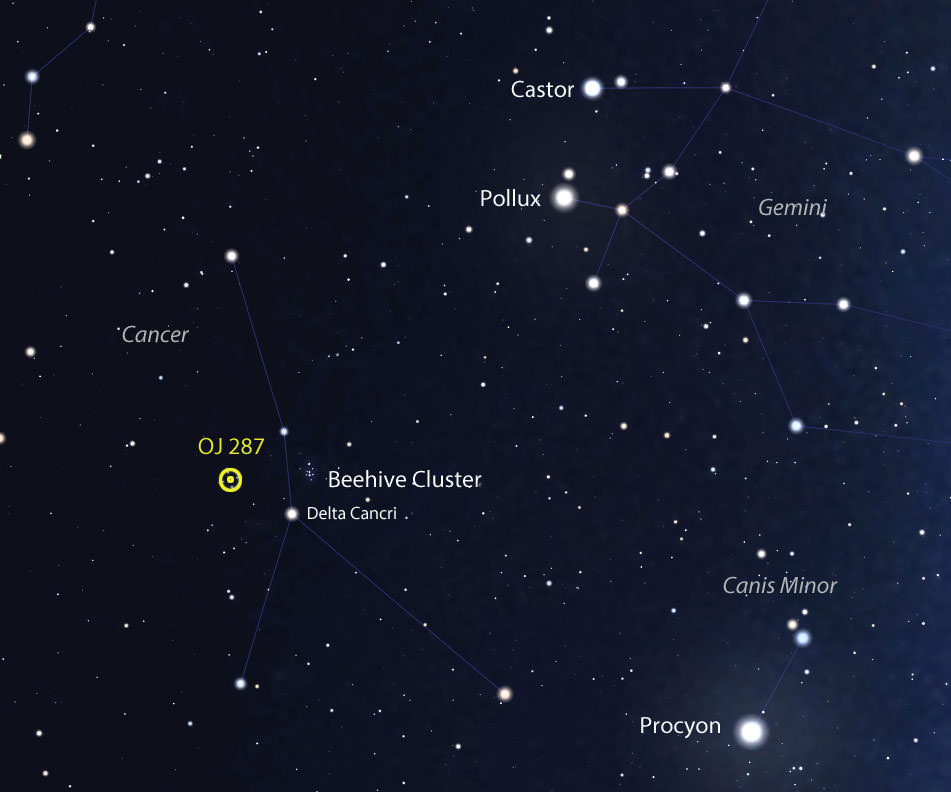
The timing of this bright outburst allowed Valtonen and his co-workers to directly measure the rotation rate of the more massive black hole to be nearly 1/3 the speed of light. I’ve checked around and as far as I can tell, this would make it the fastest spinning object we know of in the universe. Getting dizzy yet?

